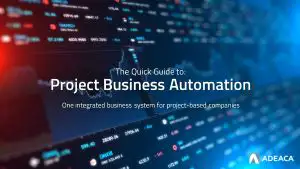Managing large, complex projects is no easy task. With the number of tasks, costs and risk associated with these projects, using a work breakdown structure is not unfamiliar territory. The problem is many companies use the WBS to manage both the financial and operational components of a project which poses a major project governance flaw.
To maximize performance and productivity, companies need an efficient way to manage both the operations and financials of their projects. And the only way to do so is to detach the cost breakdown structure from the work breakdown structure, especially for major, complex projects. A project that involves thousands of tasks will get to a point where it becomes impractical, if almost impossible to manage the project financials based on the schedule. The solution is to employ a cost breakdown structure (CBS) parallel to your WBS.
The Problem: Operating Only in the WBS with SAP
Unfortunately, many project solutions, including SAP EPPM, do not separate the operational and financial aspects of a project. In SAP, the WBS encapsulates both the operations and financials of a project. According to SAP, the WBS “forms the basis for organization and coordination in the project.” It also “shows the amount of work, the time required, and the costs involved in the project.”
While there’s some overlap in the definition of the WBS in terms of how a project is organized in a hierarchical structure and specific elements broken down into tasks and subtasks, in SAP, manual cost planning in the WBS is the only way to enter the costs expected to occur during a project.
When using SAP for project management, having only a WBS to manage both the operations and finances of a project becomes messy. Oftentimes, many businesses still end up purchasing third-party applications and using lots of spreadsheets to meet their needs.
WBS: Planning and Executing the Project Operationally
The purpose of the WBS is to plan the schedule for each project. In a WBS, each task duration is planned in conjunction with its required predecessors and following tasks. In essence, the WBS “breaks down” the structure of a project into manageable tasks that can be assigned to specific people or teams to execute. It provides an overall plan so that each project manager can see how the project should progress and manage the workflow appropriately.
CBS: Financial Planning and Execution
The CBS is a breakdown of the various costs in a project. It manages the financial aspect of any project and creates a structure for applying measurable cost controls. For the most part, the CBS is missing completing in most project tools, including project management, scheduling and the ERP. Sometimes it’s created and managed in a spreadsheet, or as mentioned above, manually entered in the WBS, which leads to error and sometimes neglect because it’s hard to keep it updated.
Adeaca Project Business Automation
Project Business Automation (PBA) is a new category of software solutions designed for project-driven business that integrates all core project business processes into one comprehensive system. When you connect PBA to your ERP system, you’re able to streamline your project business processes and make better decisions faster.
As part of PBA, a dedicated CBS makes it easy to manage your project financials at the level required for your business. This CBS is then linked directly to tasks in the WBS, so the schedule and the costs are always up to date.
To learn more about Project Business Automation, download our PBA Quick Guide.
Regardless of the industry you’re in, if projects are an important part of your business, it’s important to manage the business side of those projects. You need to be able to integrate your project business data to whatever ERP system you use, whether that’s Dynamics 365 Finance, SAP, and others. Doing so eliminates the need to manually input project data into your system, which means you can be confident that your data is free from the increased risk of error that comes with manual processes.











